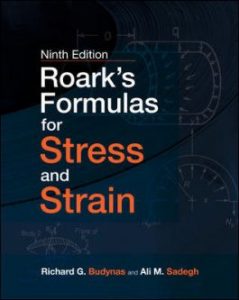- Home
- About
- Training Courses
- ASME Classroom & Virtual Courses
- API Classroom Courses
- E-Learning
- ASME Level 1 eLearning - Full Course
- ASME Plant Inspector Level 1 – Block 1 (Intro and Modules 1 and 2)
- ASME Plant Inspector Level 1 – Block 2 (Modules 3-5)
- ASME Plant Inspector Level 1 – Block 3 (Modules 6-8)
- ASME Plant Inspector Level 1 – Final Examination Module
- ASME Level 2 eLearning - Full Course
- ASME Plant Inspector Level 2 – Block 1 (Modules 1-3)
- ASME Plant Inspector Level 2 – Block 2 (Modules 4-7)
- ASME Plant Inspector Level 2 – Block 3 (Modules 8-10)
- ASME Plant Inspector Level 2 – Final Examination
- API 579 Fitness For Service
- API 571 Corrosion and Materials
- API 577 Welding & Metallurgy
- API 580 Risk Based Inspection
- API 510 CPD Training
- API 570 CPD Training
- API SIFE
- API 1169 Pipeline Inspector Certification Course
- API 936 Refractory Personnel Certification
- Technical Courses
- API CPD Recertification
- Training Courses
- Technical Hub
- Virtual Training
- FAQs
- Contact
- Online Training Portal
- Shop
- Privacy Policy
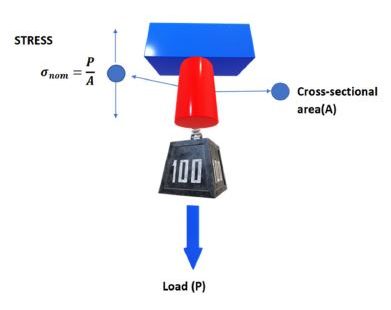
- In: Training | On: Jul 1, 2021
What is stress?
What is stress?
Introduction
In the most simplistic term, stress is simply a force divided by area. The most common unit we see in pressure equipment codes and standards is pounds per square inch (psi) for those that like imperial (and let’s face it, not many do). Or if you like to use SI units (metric) then we will often see this as Newtons per square millimetre. Note that these units also represent ‘pressure’, but in SI you’re more likely to see Megapascals used. Not a problem as 1 MPa is equal to 1 N/mm^2.
Although many will describe stress using different explanations, we can standardise this by referring to the popular Fitness For Service Standard API 579 /ASME FFS-1. The following basic definitions are found Part 1 of API 579-1, Fitness-for-Service:
• Primary Stress: “A stress developed by the imposed loading that is necessary to satisfy the laws of equilibrium of external and internal forces and moments.” [API 579-1 (2016), para. 1A.79]
• Secondary Stress: “A stress developed by the constraint of adjacent parts or by self-constraint of a structure.” [API 579-1 (2016), para. 1A.90]
If you really want to know more, Roark’s Formulas for Stress and Strain makes for some great bedtime reading! Aside from the calculations within the book, the descriptions are excellent.
The authors of this book define stress simply as; “a distributed force on an external or internal body”.
Where do these forces come from when relating to pressure equipment? Well many forces exist, but for simplicity in this article, we’ll state that the force comes from the internal pressure of the fluid. Just keep in mind that other forces can come from bending, hydrostatic loads, the weight of the component, thermal loadings. There are many to consider.
Primary Stresses
Since primary stress must satisfy equilibrium, the structure will fail – or at least experience significant deformation if the primary stress is significantly high. This stress is NOT self-limiting and failure can occur on a single application of load. The simplest example of primary stress is a weight on a rod as illustrated in Figure 1.
Another way to look at it: A primary stress is a principal stress, shear stress, or bending stress generated by imposed loadings that are necessary to satisfy the simple laws of equilibrium or internal and external forces and moments.
Not Self-limiting means as long as the load is applied, the stress will be present and will not diminish with time or as deformation takes place. The failure mode of a primary stress is gross deformation progressing to rupture. Examples of a primary stress are circumferential stresses due to internal pressure and longitudinal bending stresses due to gravity.
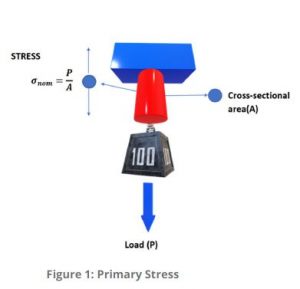
Perhaps the most important thing to realise is that a structure can fail from a single application of a primary load. Secondary loads are more of a problem under repeated
cyclic loading, i.e., fatigue. Primary loads typically have the characteristic of being ‘persistent’ loads. That is, the load is not relieved as the system deforms. You might also hear the terms, ‘following
load’ or ‘load control” to describe this phenomenon. In the B31 Codes, the term ‘sustained load’ is used.
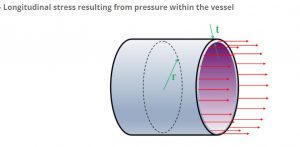
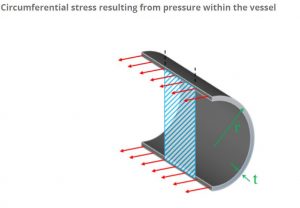
There are several examples of primary load in pressure systems, most importantly – hoop stress and longitudinal stresses due to internal pressure. In piping systems, gravity acting on an unsupported span is also a primary load.
Primary Membrane vs. Primary Bending
Primary stresses are sometimes subdivided into membrane and bending stresses. Membrane stresses are stresses that are uniform through the thickness. Bending stresses have a linear through-wall gradient (usually). The stresses in Figure 1 are primary membrane stresses, as are the stresses in a cylinder or sphere due to internal pressure.
On the other hand, primary bending can be a little confusing. There are relatively few areas in the pressure systems where primary bending occurs. The most straightforward example is the bending stress in the centre of a flat head or the crown of a dished head. Like all primary stresses, primary bending must satisfy equilibrium or failure of the component will result.
Secondary Stresses
Let us look now at secondary stress. Consider Figure 2 where the same bar is loaded by a turnbuckle rather than by a weight. If the buckle is turned five turns, creating a certain load, the bar is elongated by that imposed load. However, this load is not “persistent” – meaning it does not continue to load the component as it deforms. Once the bar has stretched to this new length, the load from the buckle does not continue to elongate. This loading is self-limiting.
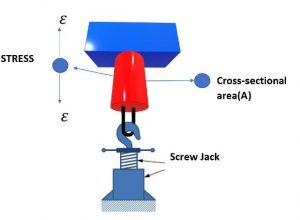
A secondary stress is a principal, shear, or bending stress caused by structural restraints. In API 579 these are referred to as Major Structural Discontinuities. Some examples include:
- Vessel insulation support ring
- saddle supports
- nozzles
- pipe supports
- conical to shell transitions
The basic characteristic of a secondary stress is that it is self-limiting. As this stress condition develops in the component, local yielding will occur, thus reducing these stresses. An example of a secondary stress is the bending of an elbow that joins two lengths of pipe subjected to a temperature increase. As the piping reaches its operating temperature, the bending strain (stress) in the elbow will reach a maximum magnitude and the strain (stress) will stabilize. Thus, the condition causing the stress to increase stops; the elbow, now in this new higher stressed state, will in time experience local yielding or deformation that will reduce the stresses in the elbow. One can see from this example that secondary stresses in a piping system are associated with cyclic conditions such as temperature increase or decrease, and although not specifically discussed in B31.3, it is worthy of being added to the list of definitions.
So, in summary;
Primary stresses:
• maintain equilibrium with applied loads. If the primary stresses are too high, the structure will fail in a single
application of load.
• are not self-limiting.
• primary loads are also called “persistent” or “following” loads.
Secondary stresses:
• are generally the result of local stress concentrations. They will not fail the structure from a single application of load.
• are self-limiting.
• result from displacement controlled loading, such as those from thermal stresses.
• primary stresses are more dangerous because they can result in a net section failure or gross distortion upon a single application of load.
• generally, secondary stresses are more of a problem in fatigue than in non-cyclic service.
• elastic follow-up occurs when displacement controlled loads can generate large displacements that “act” like load controlled loading.
We cover these topics on most of our courses. but we’ll be getting these explanations up on our new YouTube channel soon!

